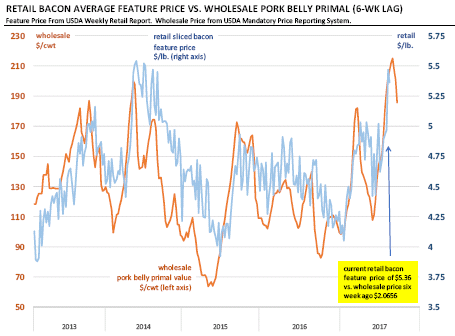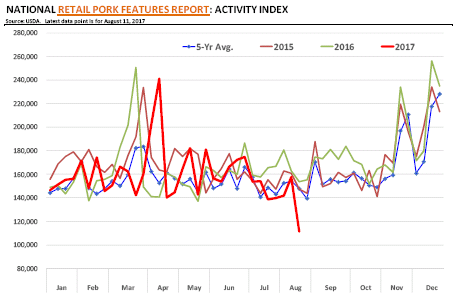



CME: Smaller Than Expected Hog Slaughter Numbers
US - The sharp break in pork belly prices last week was something that market participants had been pondering for a while but the speed with which it took place certainly got futures to pay attention, according to Steiner Consulting Group, DLR Division, Inc.Earlier in the week hog futures actually rallied on reports of smaller than expected slaughter numbers and generally positive export data. But as we noted in our report on 15 August, there was also a lot of doubt about the sustainability of lofty pork prices into the fall.
One of the bearish indicators we highlighted in our report was the 10 per cent jump in the retail feature price reported by USDA for the previous week. The chart below is something we have shown before, illustrating the relationship between the weekly retail feature price vs. wholesale prices six weeks prior.

The idea is that it likely takes about six weeks before the changes in wholesale prices make their way into the retail case. It is not a perfect measure and other factors, such as cold storage inventories and foodservice demand, will also play a role in this adjustment.
The point, however, is that eventually retailers will pull bacon off ads when landed costs catch up with wholesale prices. And the lags in how pricing works may sometimes exacerbate short term price momentum.
For the week ending 18 August, USDA reported the national average price of sliced bacon at $5.36 per pound, 2 per cent less than the week before but now 22 per cent higher than it was in early June. These are some of the highest bacon retail prices since the summer of 2014.

The retail pork activity index was down sharply last week, likely reflecting the retailers no longer promoting bacon sales. The activity index is reported each week by USDA and it looks to measure the absolute number of pork items being featured.
For the week ending 18 August, the national pork retail activity index stood at 111,125, 27 per cent lower than a year ago and the lowest index reading since the data collection started in 2011.
The activity index for most items measured by USDA was lower for the week but processed items, which includes bacon and sausage, showed the largest decline. This seems to track with the significant weakness we have seen recently both in the belly market and in pork trim values.








